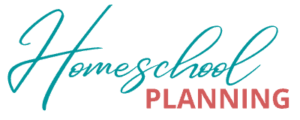Language arts is a subject often taught in school and many homeschoolers are required to teach as well. But what exactly is language arts, what does it cover, and why is it important?
If you’ve found yourself wondering how to teach language arts in your homeschool, then I’m glad you’re here.
In this post, I will give you the basics of what it means and why it’s important to teach – and not just because it’s required! I will also give you ideas on how many homeschoolers approach language arts in their homeschool. Then I will wrap it up with a progression of how I include language arts in our homeschool year by year, including some curriculum ideas!
Let’s get to it!
*Note: This post contains affiliate links, which means I receive a small commission, at no extra cost to you, if you make a purchase using the link. Please see my disclosure for more details.
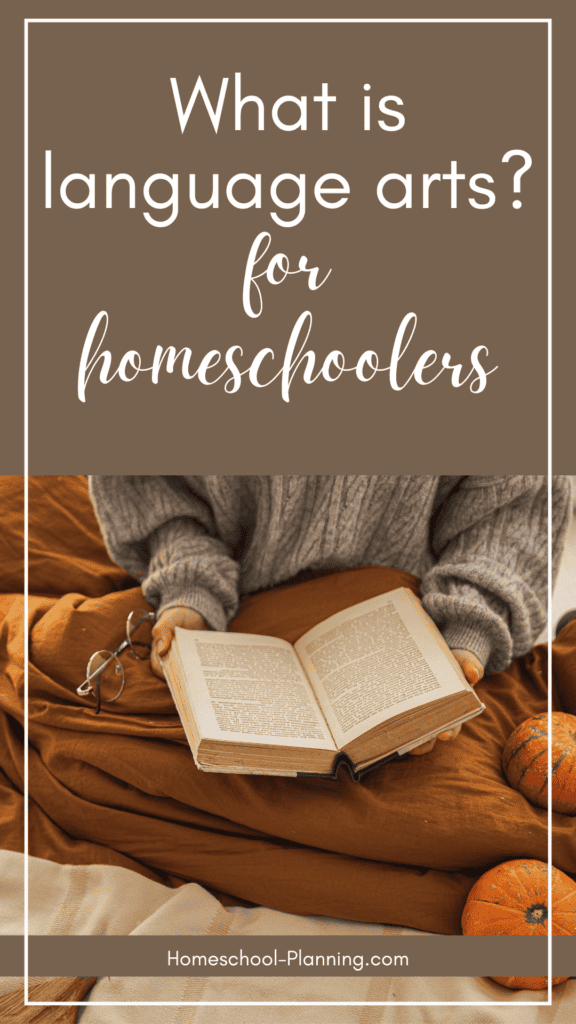
What are Language Arts?
In US schools, Language Arts is a subject that covers the arts of communicating the English language. This includes skills like writing, reading, listening, and speaking. These arts are represented in a curriculum through various topics like grammar, spelling, and phonics to zero-in on specific skillsets for practice.
Since the art of communication includes many parts, a language arts program does not often practice each topic individually. Nor are all topics presented equally or practiced in depth every year. Many skills of language arts are taught in a combined way, like teaching grammar, spelling, and writing skills through composing and editing an essay.
Parts often included in a comprehensive language arts program:
- Writing (academic and creative)
- Spelling
- Phonics
- Literature
- Vocabulary
- Grammar (structure, punctuation, etc.)
- Public speaking
- Dictation
- Reading
- Copywork
- Editing
- Listening
- Literary analysis
- Reading comprehension
- Composition
- Handwriting

What is ELA?
The abbreviation ELA typically stands for English Language Arts. In some public schools, this term covers a different range of topics than a language arts or English class covers. But for most in the homeschool world, any of these terms are typically used interchangeably. They usually refer to a school subject or curriculum that covers the whole range of language arts topics, including reading, writing, grammar, literature, spelling, vocabulary, and more.
Why is language arts important?
Many kids may grow up thinking they do language arts to get a good grade. Or to make their teacher happy. Maybe they think a little deeper and think they do language arts so they can write books, then get confused why they need to continue if they don’t want to be a writer.
So why do we do language arts in our schools? What makes ELA an important subject?
Well, it goes back to what language arts is. It’s all about communicating and learning to communicate better through every form like writing and speaking.
When we practice language arts, we learn new vocabulary so we can make our communication more interesting and clear. We learn how to spell and form letters correctly so others can understand what we wrote down. We learn to form good sentences so what we want to communicate is received accurately.
Language is formed by thought. We produce ideas then mold them into words, sentences, and paragraphs. We plan, organize, edit, and improve it as we grow in our skill. This is how we communicate with our language. It is an art.
We get better at doing all of this through listening and learning from others. Reading writing from others. Then using our new skills to write and speak to others.
So reading, listening, learning, and speaking will ultimately increase our ability to clearly communicate our basic thoughts and ideas. It is a formal way to learn this art.
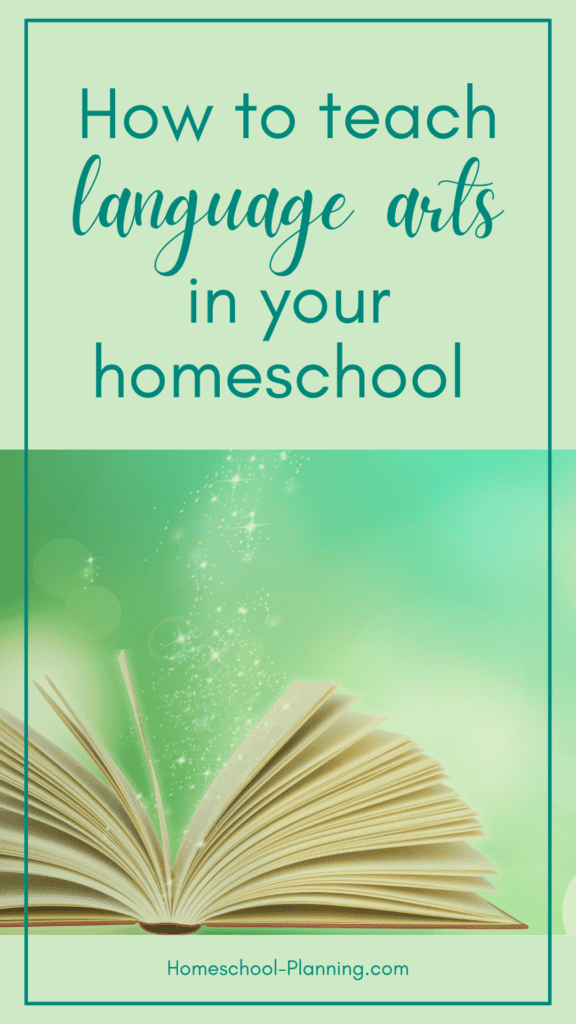
How do I teach language arts in my homeschool?
There are many ways to approach teaching language arts in your homeschool. Some families use a seperate ELA curriculum, while others will incorporate language arts skills into other subjects like history and science. Still others may focus on reading good books and using narration, copywork, and dictation for a more classical approach. All of these approaches seem to work well for many families and are great for increasing skills in communication of thought.
The important thing is that you are challenging your students to think and communicate their thoughts. Planning and executing good stories and writings can be difficult but are so important for increasing skill.
Thinking of language arts as including all the aspects of language from listening to reading to writing to speaking will benefit every aspect of thought. And doing these things on a regular basis is most important for building upon previous skills.
Remember that no matter what you use and how you use it that one of the best things you can do for your children and their language skills is to read out loud to them. So no matter the age, try to keep this one thing a part of your language arts program!
Beyond using curriculum and doing workbooks, there are many ways to make language arts more fun. Here are some fun ideas for including ELA in your homeschool:
- Write about what you are learning.
- Summarize what you read.
- Make up a fun story.
- Do Mad Libs.
- Edit paragraphs with errors.
- Write limericks or haikus.
- Write a story to go with a picture you find or draw.
- Label the parts of a sentence together.
- Read poetry with a snack.
- Participate in a book club.
- Copy sentences from a favorite story.
- Write letters to friends or relatives.
- Build a comic story.
- Read aloud to a sibling or pet.
- Research a favorite topic and write about it.
- Have a poetry tea time.
- Write poetry and put it to music.
- Read a book then watch the movie.
- Read together for a great shared experience.
- Talk about what you are learning and experiencing.

Homeschool styles of english language arts
There are a lot of ways to teach english language arts in your homeschool. Many families will have a certain style or philosophy for learning, and these methods will come through in how they teach ELA. Here are a few of the more common styles of homeschooling and how they might approach teaching language arts.
Read: 17 Types of Homeschool Styles and Methods
All-in-one
All-in-one programs are all-inclusive instruction in the aspects of language arts. These programs often spend the most time on reading, writing, spelling, vocabulary, and grammar. They often do not go very deep in any one aspect, but incorporate all into short lessons.
They also often rotate through the aspects throughout the week rather than doing each part every day. So there may be assigned reading one day with some questions to answer on day 1, with a short writing project the following day and editing the next. Then they may look at some new words and discuss literary aspects at the end of the week.
This can help keep the learning interesting and engaging without taking a lot of time and energy.
Example: Abeka Language Arts or The Good and the Beautiful
Charlotte Mason
The philosophies of Charlotte Mason use classic literature as a means to approach learning. Families will read great books on various topics, then pull passages for copywork and dictation to practice skills like grammar and spelling. Narration is used for working on communicating thought, and as kids get older, narrations are written.
Example: Ambleside Online
Classical
Classical learning has similar approaches as Charlotte Mason, using copywork, dictation, and narration. Classical learning usually adds Latin instruction to understand roots of our language. As kids get older, more intensive grammar, writing, and public speaking instruction is also included.
Example: Writing With Ease and First Language Lessons
Literature-based
Like some other homeschool styles, literature-based curricula use books as a basis for all learning. But many of these curricula will incorporate reading newer books which will seperate them from others. Also, many literature-based programs have their own curriculum to go along with the books, with actual instruction included, rather than solely relying on the literature to do the teaching.
Often literature-based programs include all aspects of ELA instruction. They often use vocabulary and topics from the books read, but use more modern approaches and exercises like essay writing and editing.
Example: Bookshark
Eclectic
An eclectic approach to teaching language arts will use a variety of programs to build a complete language arts curriculum. Eclectic homeschoolers may use a writing program alongside seperate spelling and grammar programs. This allows students to focus more on certain needed skills each year and go less in-depth on topics that they are doing well in. You can do some of each program every day, or rotate through them, doing only one or two each day.
Examples: Timberdoodle or my progression below
Unit Study
A unit study approach to teaching language arts is done by incorporating it into the topics learned in other subjects. Your family may be learning about reptiles, so you might research a favorite reptile and write a paragraph about it. You may learn the names of reptiles and copy them for practice in spelling and vocabulary. This approach often does not have as much direct instruction in the details of language arts.
Example: Five in a Row
DIY
Many families may choose to DIY their own ELA curriculum for their kids. This may look like writing book reports on what they read, researching and writing about a topic from another subject, editing their writings, reading a variety of books, and pulling vocabulary and spelling lists from what they are learning.
This can be a great way to keep things fun and interesting, but can be challenging for parents to actually teach the how and why of good structure and punctuation skills on their own.

All-in-one curriculum or seperate parts?
Many families start homeschooling using an all-in-one curriculum. Then over time decide you want to spend a little more time on a certain subject or topic. Or you may decide that the all-in-one program doesn’t go into as much depth as you would like.
So after a while, you add in a spelling program. And maybe a seperate grammar program. Quickly you find that you are doing many different programs for language arts.
This is a great way to customize your child’s education! It is also a great way to find yourself going a lot of directions and spending a lot of time just on language arts. Ask me how I know. 🥴
But the truth is, just like the all-in-one programs do, you also don’t have to teach all the seperate parts of language arts every day. You can rotate.
For instance, last year, my daughter did a writing program and a grammar program. I had her rotate these, only doing one each day. As they were both full-year programs, this ended up taking most of two years to get through both programs, but helped her get the depth of learning I wanted without overwhelming her with a lot of work each day.
She also worked through spelling and vocabulary each day as well as reading great books.
Another way to do this could be to rotate the parts you do each year. You may do a writing curriculum every year, then switch between other parts. Like you may do a grammar program every other year, and a literature program in between. Or switch between spelling and vocabulary. You get the idea.
And also understand that if your child is great at spelling, you don’t have to continue with a spelling program! You could let it go altogether or perhaps switch to a vocabulary program instead. The latter is what I did with my son, but my daughter has needed continued spelling help. It’s just not natural for her.

Some personal thoughts on language arts instruction
In the next section, I will lay out a possible progression for teaching language arts in your homeschool. This is the progression I use with my kids that I have found works well for us. But before we get into it, I want you to understand a few things about how I approach language arts in our homeschool.
I will let you know now that I am not a certified teacher. But we are in our eleventh year of homeschooling and my kids have scored well above grade level in standardized tests. Plus, we use strong curricula written by experts in their fields, so I believe my certifications are generally irrelevant anyway.
These thoughts have been developed not just through my personal experience as a second generation homeschooler, but also from talking with and learning from many other homeschool families over the years.
So on to my thoughts:
1. I do not assign certain books for my kids to read until at least grade 6.
Even then, I allow my kids to choose a few from a list of options. I firmly believe that kids need to learn to love books and reading before we force them to read certain things. Assigning reading for my kids (and myself) has often taken away any joy found in the stories.
Now do I encourage them to read from various genres or suggest certain books I think they will enjoy? Absolutely! But I have found the more I force them to read, the less they will want to do on their own.
Also, any books I want my kids to read, I end up reading aloud to them in our group learning time each day. We read a lot of historical fiction and more difficult literature together this way. Even my high schooler participates in this.
So it’s a win-win. They still get the great books while choosing what they want to read on their own.
If these ideas intrigue you, I highly recommend you listen to this podcast by Sarah Mackenzie about teaching literature.
2. I focus mainly on phonics and reading instruction until my kids are fluent readers, or at least till grade 2 or 3.
Phonics and reading instruction is important before any other ELA instruction is needed. I think it is difficult to ask a child to spell or write a word if they aren’t solid in reading it first. I don’t think they need to understand what a noun is if they cannot first read the word noun. There is no need to show them where a period goes if they can’t first read a sentence.
3. I believe solid phonics instruction is important to be able to read well.
Some mixed-in sight words are ok, but that should not be the focus. Sight words only encourage memorizing words and do not allow kids to quickly excell at a bigger vocabulary on their own.
4. I use several programs together for a full curriculum
I prefer to not use a comprehensive ELA program for lanugage arts instruction, but instead I create my own full curriculum by using seperate programs for each part of language arts. What parts of language arts we cover each year partly depends on my child’s needs that year, and the depth I want them to work on various skills each year.
I think most comprehensive programs are not challenging enough nor cover the depth I want my kids to learn each year. So using these seperate programs helps with those issues. Of course, this means my kids do end up doing more language arts some years.
While language arts skills do repeat and build each year, I want my kids to have a solid grasp on most basic topics before they enter high school. So they will be able to focus more on refining these skills at that point.
5. I switch between publishers each year for some parts
You’ll notice in my progression below that I don’t use the same writing program year after year with my kids. This is mainly because I like for them to get different perspectives and styles on writing well. There are so many approaches and I couldn’t just pick one!
We have stuck with the same math curriculum all the way through. But for some reason, I haven’t done this with writing. Though I have found a few favorites we go back to occasionally. Will these always be my favorite? Possibly not. But this is what are using for now.
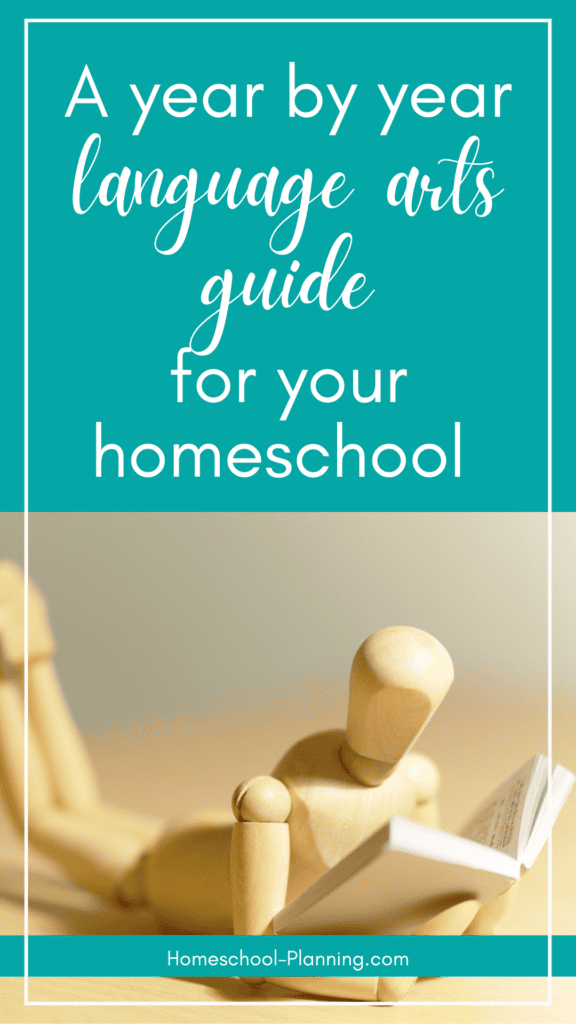
Possible language arts progression
Over the many years I have been homeschooling my children, I have been a researcher. I love to look at and research curriculum. Because of this, I have created a general progression of programs that I use with my children over the years of homeschooling for language arts instruction.
Of course, each child is different, but I have often found that I can easily accomodate my children by making changes to our approach to a curriculum rather than switching curricula completely. But that of course has just been our experience.
So here is the list of subjects we focus on within each grade level along with the programs we use for each. It is not what we have always used, as we have tried many other programs and ended up giving them up. But this is where we have landed after my first being a guinea pig.
I hope this pathway helps you create a curriculum that works for your family.
Basic progression summary
- K-grade 2: Focus on handwriting and phonics. Real aloud to them.
- Grade 2-5: Basic writing, spelling, and handwriting. Add cursive. Basic grammar in grades 2 and 4. Read aloud to them and encourage a love of reading on their own.
- Grade 6-8: Continued writing, spelling, and handwriting. Possibly add vocabulary. Include an intensive grammar program over 1-2 years. Read aloud to them and encourage a love of reading on their own. Some assigned reading.
- High school: In-depth writing instruction of various types, encouraging incorporation of all the arts of language. Encourage reading a variety of books and types of literature with some assigned reading. Read aloud to them and encourage a love of reading on their own.
Preschool
In preschool, I focus on letter recognition and learning letter sounds (early phonics) with lots of read-alouds. I try to keep this fun, playful, and optional. We spend no longer than 20-30 minutes on formal learning each day, and only if they are interested.
What we use: Alphabet lapbooks from Homeschool Share, followed by Explode the Code A, B, and C followed by The Good and the Beautiful Kindergarten Prep book.
Kindergarten
In Kindergarten, I try to keep formal learning short and fun. I focus on handwriting (basic letter formation) and Reading/Phonics instruction with lots of read-alouds.
What we use: All About Reading Level 1, Zaner Bloser Handwriting
Grade 1
In first grade, I continue to focus on handwriting (basic letter formation) and Reading/Phonics instruction with lots of read-alouds.
What we use: All About Reading Level 2, Zaner Bloser Handwriting
Grade 2
In grade 2, I like to add basic grammar instruction alongside continued Reading/Phonics, handwriting (cursive if desired), and lots of read-alouds. Kids should read books on their own as well.
What we use: All About Reading levels 3 and 4, Zaner Bloser Handwriting – cursive, and Easy Grammar grade 2
Grade 3
By grade 3, I find that phonics is no longer necessary to cover in-depth, especially if kids are reading well. I begin using a basic writing/composition program with some grammar instruction. Spelling is great to add at this point. Continue handwriting practice and reading aloud. Encourage children to read on their own.
What we use: Essentials in writing 3, Building Spelling Skills level 3, and Zaner Bloser Handwriting and/or Bible copywork.
Grade 4
In grade 4, I continue with composition instruction and do a more in-depth grammar program. We continue spelling alongside basic copywork for handwriting practice. Continue reading together as well as independently.
What we use: Wordsmith Apprentice, Easy Grammer 4, Building Spelling Skills 4, and Bible copywork.
Grade 5
Grade 5 is a lot like grade 4, with continued composition, grammar if desired, spelling, and copywork. Continue reading together and encourage reading independently.
What we use: Essentials in Writing 5, Finish Easy Grammar 4 if needed, Building Spelling Skills 5, and Bible copywork
Grade 6
Grade 6 is really more of the same, but of course the bar is higher now that they are in middle school. In middle school, I begin grading work more seriously and giving feedback. I take this year off from a grammar program and focus mainly on writing. We add in vocabulary at this point and continue spelling and copywork if desired. Continue reading together and encourage reading independently. Some assigned reading.
What we use: Jump in (first half), Wordly Wise 3000 level 6, Building Spelling Skills 6, and Bible copywork
Grade 7
In grade 7, I like to do some more intensive grammar study along with writing and vocabulary. Continue spelling and copywork if desired. Continue reading together and encourage reading independently. Some assigned reading.
What we use: Jump In (second half), Analytical grammar 4, Wordly Wise 3000 level 7, Building Spelling Skills 7, and Bible copywork
Grade 8
In grade 8, we finish up a grammar program if needed, and continue composition and vocabulary. Spelling and copywork if desired. Continue reading together and encourage reading independently. Some assigned reading.
What we use: Wordsmith, Analytical Grammar 5, Wordly Wise 3000 level 8, and Bible copywork.
High School
In most states, high schoolers need 4 credits of ELA. This should include all aspects of language arts, mainly composition and literature. But within this, there are so many great options it has been difficult to decide.
My son is only in 9th grade, so I have not used many high school programs yet, but have listed below the programs we are using this year as well as some options I am considering for the rest of high school.
I still do not make a big deal about using an actual literature program in our homeschool, but do encourage and even assign a few great books to read each year. My son also currently has the option to take literature at our coop.
So since my kids already have a solid foundation in grammar and such, in high school we are focusing on composition and reading. I do also have them continue vocabulary. We still read together and independently.
What we have used so far: Power in Your Hands (over 2 years), Wordly Wise 3000 Vocabulary, and reading great books
What I’m considering for the future: Essentials in Writing, Essentials in Literature, 7 Sisters English, Writing Fiction in High School, and/or Institute for Excellence in Writing
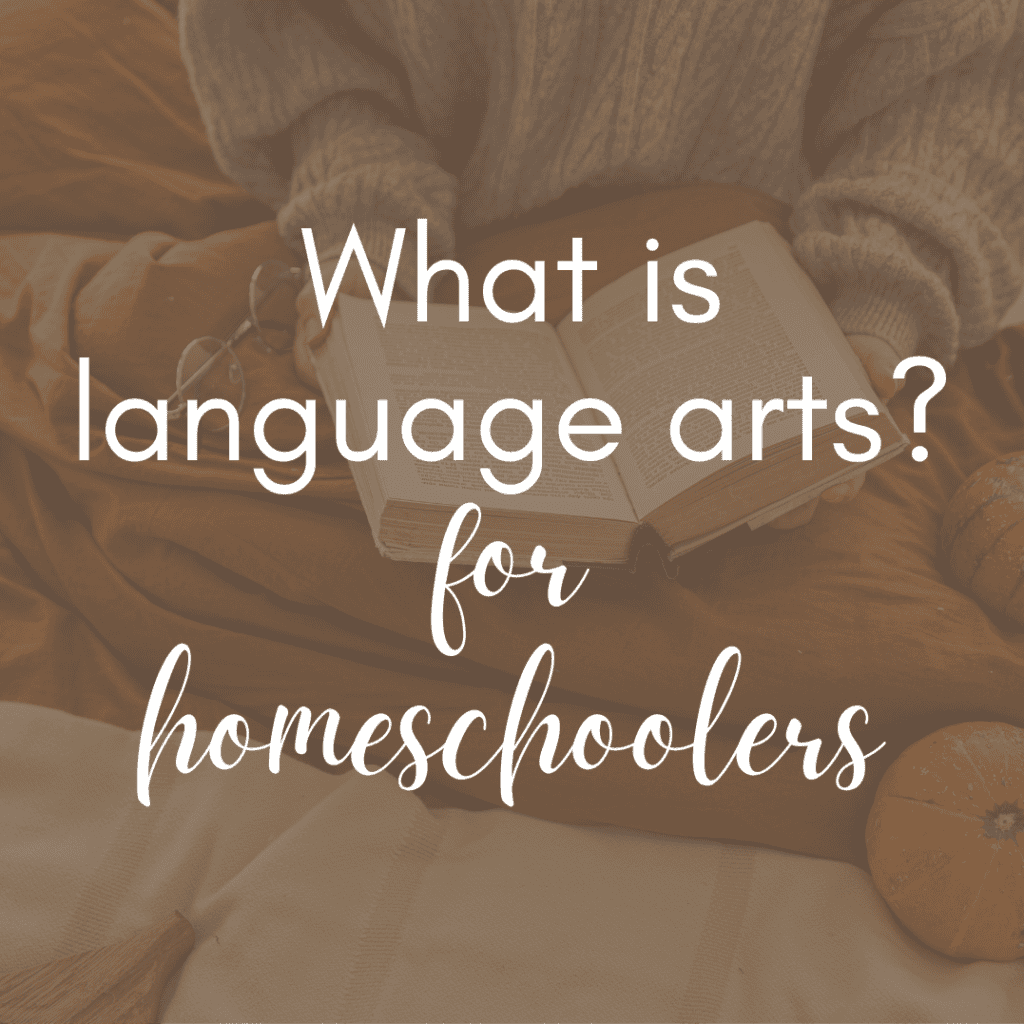
What is language arts?
Language arts is all about the art of communicating effectively by listening, reading, writing, and speaking. These skills are developed through applied activities like spelling, composition, grammar, literature, and vocabulary. Refinining English Lanuage Arts (ELA) skills will help you to learn how to plan and organize your thoughts for more effective written and oral communication.
While it can be difficult to know what to teach when, I hope with this breakdown, you now have a solid understanding and path forward with your homeschoolers.
How do you like to teach language arts in your homeschool? Comment below, I’d love to know!
Related posts
17 Types of Homeschooling Styles and methods
Top 23 Literature-based Homeschool Curriculum Options
